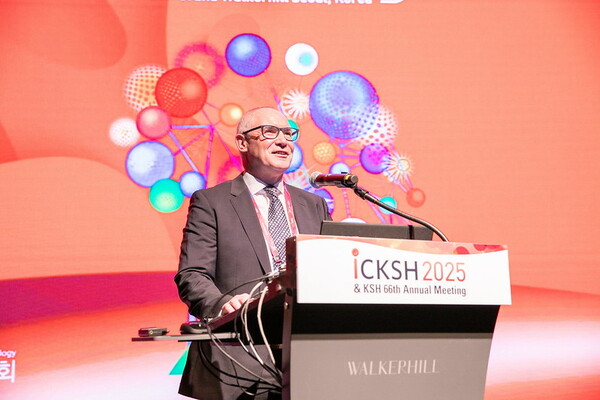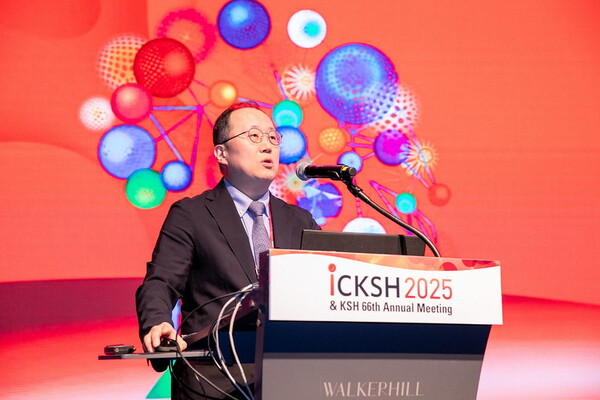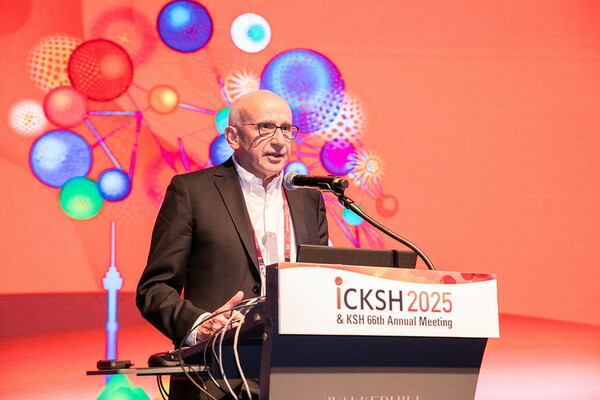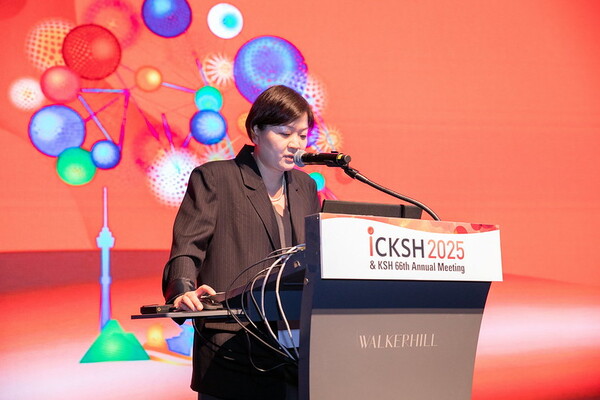As acute myeloid leukemia (AML) treatment evolves from broad-spectrum cytotoxic approaches to personalized, molecularly guided therapies, global experts are emphasizing the need to redefine risk assessment, therapeutic timing, and post-treatment monitoring.
The increased integration of genomic profiling and next-generation sequencing (NGS) into AML practice is enabling earlier detection of high-risk features, more precise patient stratification, and optimized use of novel targeted agents.
These shifts are not only improving survival but also reshaping how clinicians approach treatment decisions in both newly diagnosed and relapsed patients, prompting leading hematologists to gather at ICKSH 2025 in Seoul to discuss how molecular science is reshaping both research and clinical strategies.
At the joint session co-hosted by the European Hematology Association (EHA) and the Korean Society of Hematology (KSH), experts from the U.K., Germany, and Korea presented emerging data on transcriptional dysregulation, genetics-guided therapies, and real-world Korean cohort findings.
Their insights underscored the growing importance of integrating next-generation sequencing (NGS), targeted therapies, and risk-adapted monitoring into routine AML management.

Aberrant transcriptional programs drive AML pathogenesis
Professor Brian Huntly at the University of Cambridge provided an in-depth analysis of transcriptional abnormalities in AML, highlighting how gene regulatory complexes (GRCs) composed of transcription factors and chromatin modifiers sustain leukemic cell identity.
Huntly emphasized that while genetic mutations have long been studied in AML, it is their downstream transcriptional effects—particularly in enhancer landscapes—that often determine disease behavior.
“AML is fundamentally a disorder of disrupted transcriptional regulation,” Huntly said.
One of the central molecules in this process is the transcription factor ERG, which in AML creates new enhancers that hijack normal hematopoietic gene expression.
“We’ve observed that ERG overexpression plays a direct role in promoting leukemic transformation and correlates strongly with relapse,” he said.
Huntly also shared preclinical findings suggesting that pharmacologic suppression of ERG activity could reverse leukemic phenotypes in vitro.
Several early-stage compounds are under investigation, aiming to disrupt ERG-mediated gene regulation.
“Our data suggest that targeting these transcriptional programs may be as effective—and perhaps even more durable—than blocking upstream mutations alone,” he said.

Clinical realities and treatment access in Korea
Professor Cheong June-won at Yonsei University College of Medicine presented a comprehensive overview of AML treatment trends in Korea, focusing on patient demographics, therapy patterns, and access to novel agents.
He noted that roughly 3,000 new AML cases are diagnosed annually, with incidence sharply increasing in older adults, particularly those over 70, who now make up nearly one-third of all cases.
Cheong reviewed current treatment strategies, including intensive induction (7+3 regimen), hematopoietic stem cell transplantation, and the increasing use of low-intensity therapy such as azacitidine-venetoclax combinations.
Time-trend survival data indicated improved five-year survival rates, particularly in patients under 60. However, outcomes in older patients remain suboptimal.
A major challenge, Cheong emphasized, lies in access to recently approved therapies.
Many EMA- and FDA-approved AML drugs have been introduced late in Korea and remain outside the national reimbursement system.
“We face a growing gap between what is clinically available globally and what our patients can afford,” he said. “Ivosidenib, for example, was only approved in Korea in 2024—one year after its EMA approval—and is still not reimbursed, imposing significant financial barriers.”
Cheong urged policymakers to accelerate reimbursement timelines and reduce out-of-pocket burdens.
“Without early access, patients are forced to wait or self-finance critical therapies, undermining equity in care,” he said.

Genetics-driven precision therapy gains ground in AML
Professor Hartmut Döhner at Ulm University Hospital emphasized the paradigm shift from empiric to precision-based AML therapy, focusing on actionable genetic mutations such as FLT3, IDH1, IDH2, and others.
He detailed how the integration of targeted agents—midostaurin, quizartinib, ivosidenib, and enasidenib—has significantly improved treatment outcomes in biomarker-defined subgroups.
“Genetic profiling is no longer optional in AML—it is a requirement,” Döhner said. “In patients with IDH1 mutations, the combination of ivosidenib and azacitidine has demonstrated significant improvements in overall survival and event-free survival compared to standard chemotherapy alone.”
This combination offers a tolerable, effective first-line option for older or unfit patients, he added.
Döhner also introduced next-generation investigational therapies, such as menin inhibitors for NPM1- and KMT2A-rearranged AML. Early-phase data indicate potent anti-leukemic activity by inducing cellular differentiation and apoptosis, even in refractory cases. He showed preclinical models suggesting these agents may eventually move into frontline regimens.

NGS reveals genetic complexity in Korean AML patients
Professor Ahn Jae-sook at Chonnam National University Medical School presented findings from the Korean AML/MDS Working Party’s multicenter genomic study, which analyzed 621 patients across 19 institutions using NGS.
On average, patients harbored 3.3 mutations at diagnosis. Mutation patterns were stratified by age and treatment intensity, revealing distinct profiles among those receiving intensive versus low-intensity therapy.
Ahn focused particularly on NGS-based minimal residual disease (MRD) monitoring. Using a threshold of 0.2 percent variant allele frequency, her team showed that MRD negativity post-treatment was strongly predictive of relapse-free and overall survival.
“NGS MRD adds a powerful prognostic layer beyond traditional morphological assessments,” she said.
The study also identified germline mutations in about 5.5 percent of patients, with DDX41 being the most common.
Ahn noted that these findings could impact donor selection in transplantation and family screening. “Understanding germline predispositions is crucial—not only for treatment planning but for long-term surveillance,” she said.
Her presentation concluded with a call for integrating NGS into routine care.
“Dynamic molecular tracking should become part of every AML treatment protocol,” she said. “It informs relapse risk, shapes post-remission strategies, and supports true personalization of care.”
Related articles
- [ICKSH 2025] CML care enters new era with next-gen sequencing: experts at ICKSH 2025
- [ICKSH 2025] CML therapy moves toward precision with asciminib and genomic profiling
- [ICKSH 2025] CD38 at a crossroads of immune modulation and therapeutic innovation
- Ewha’s Ryu receives academic award from Korean hematology society
- [ICKSH 2025] Reimbursement policy determines success or failure of blood cancer treatment
- [ICKSH 2025] ‘High-risk pediatric AML needs precision, not more chemotherapy’
- [ICKSH 2025] ‘Advancing genetic insights to refine treatment strategies for Down syndrome-associated myeloid leukemia’
- [ICKSH 2025] ‘Ph-like ALL treatment paradigm shifting toward molecularly guided immuno- and targeted therapy’
- [ICKSH 2025] ‘Don't let treatment kill the patient before the disease does’: Mayo Clinic doctor
- [ICKSH 2025] CAR-T therapy reshapes lymphoma treatment amid new strategies and resistance challenges
- [ICKSH 2025] ‘Multiple myeloma patients must know about their disease. Our working party will help.’
- [ICKSH 2025] ICKSH expands beyond Asia, attracts experts from US and Europe
- [ICKSH 2025] Paroxysmal nocturnal hemoglobinuria drug Empaveli targets extravasation hemolysis
- [ICKSH 2025] Korean hematologists urge faster reimbursement for lifesaving blood cancer drugs
- [ICKSH 2025] Basic principles of AI and its application in healthcare
- [ICKSH 2025] Spotlighting cutting-edge diagnostic technologies in hematology
- New therapies push childhood leukemia cure rates to 90%
- 60% of acute leukemia patients say life is harder after stem cell transplant: survey

